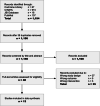Pelvic circumferential compression devices for prehospital management of suspected pelvic fractures: a rapid review and evidence summary for quality indicator evaluation
- PMID: 32660515
- PMCID: PMC7359240
- DOI: 10.1186/s13049-020-00762-5
Pelvic circumferential compression devices for prehospital management of suspected pelvic fractures: a rapid review and evidence summary for quality indicator evaluation
Abstract
Background: Pelvic fractures, especially when unstable, may cause significant haemorrhage. The early application of a pelvic circumferential compression device (PCCD) in patients with suspected pelvic fracture has established itself as best practice. Ambulance services conduct corresponding performance measurement. Quality indicators (QIs) are ideally based on high-quality evidence clearly demonstrating that the desirable effects outweigh the undesirable effects. In the absence of high-quality evidence, best available evidence should be combined with expert consensus.
Objectives: The aim of the present study was to identify, appraise and summarize the best available evidence regarding PCCDs for the purpose of informing an expert panel tasked to evaluate the validity of the following QI: A patient with suspected pelvic fracture has a PCCD applied.
Methods: A rapid review of four databases was conducted to identify relevant literature published up until 9 June 2020. Systematic reviews, experimental, quasi-experimental and observational analytic studies written in English were included. One author was responsible for study selection and quality appraisal. Data extraction using a priori extraction templates was verified by a second reviewer. Study details and key findings were summarized in tables.
Results: A total of 13 studies were assessed to be eligible for inclusion in this rapid review. Of these, three were systematic reviews, one was a randomized clinical trial (crossover design), two were before-after studies, and seven were retrospective cohort studies. The systematic reviews included mostly observational studies and could therefore not be considered as high-level evidence. Overall, the identified evidence is of low quality and suggests that PCCD may provide temporary pelvic ring stabilization and haemorrhage control, although a potential for adverse effects exists.
Conclusion: Given the low quality of the best available evidence, this evidence would need to be combined with expert consensus to evaluate the validity of a related quality indicator before its implementation.
Keywords: Pelvic fracture; Prehospital care; Quality indicator; Rapid review; Trauma.
Conflict of interest statement
The authors declare that they have no competing interests.
References
-
- Ruatti S, Guillot S, Brun J, Thony F, Bouzat P, Payen JF, et al. Which pelvic ring fractures are potentially lethal? Injury. 2015;46(6):1059–1063. - PubMed
-
- Hermans E, Biert J, van Vugt AB, Edwards MJR. Research on relation of mortality and hemodynamics in patients with an acute pelvic ring fracture. J Acute Dis. 2016;5(2):117–122.
-
- Starr AJ, Griffin DR, Reinert CM, Frawley WH, Walker J, Whitlock SN, et al. Pelvic ring disruptions: prediction of associated injuries, transfusion requirement, pelvic arteriography, complications, and mortality. J Orthop Trauma. 2002;16(8):553–561. - PubMed
-
- Dalal SA, Burgess AR, Siegel JH, Young JW, Brumback RJ, Poka A, et al. Pelvic fracture in multiple trauma: classification by mechanism is key to pattern of organ injury, resuscitative requirements, and outcome. J Trauma - Inj Infect Crit Care. 1989;29(7):981–1002. - PubMed
Publication types
MeSH terms
LinkOut - more resources
Full Text Sources
Medical


